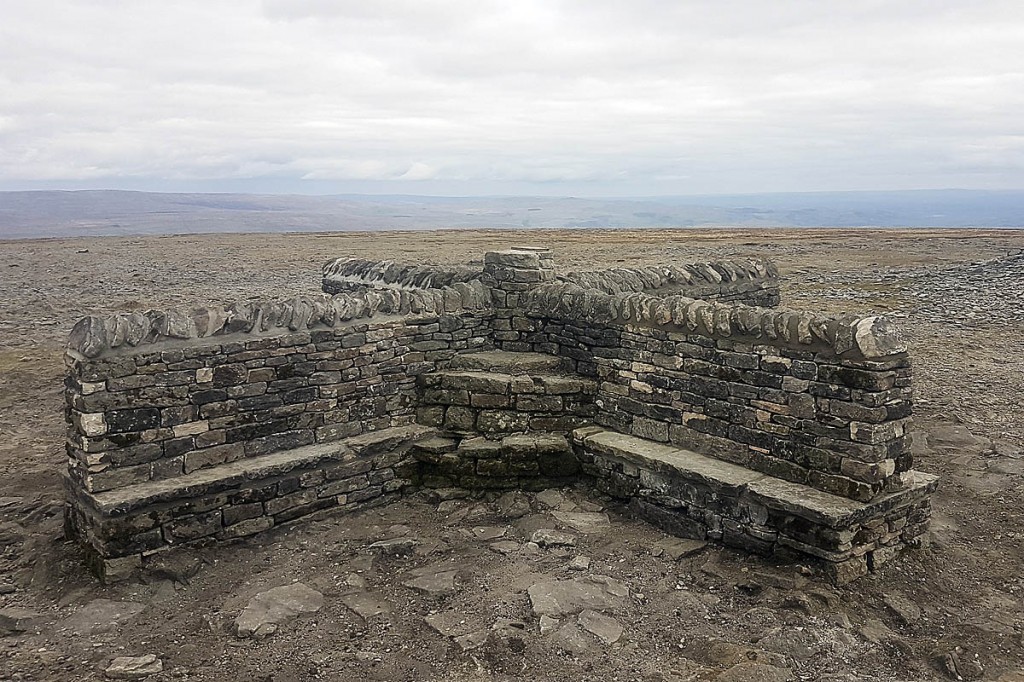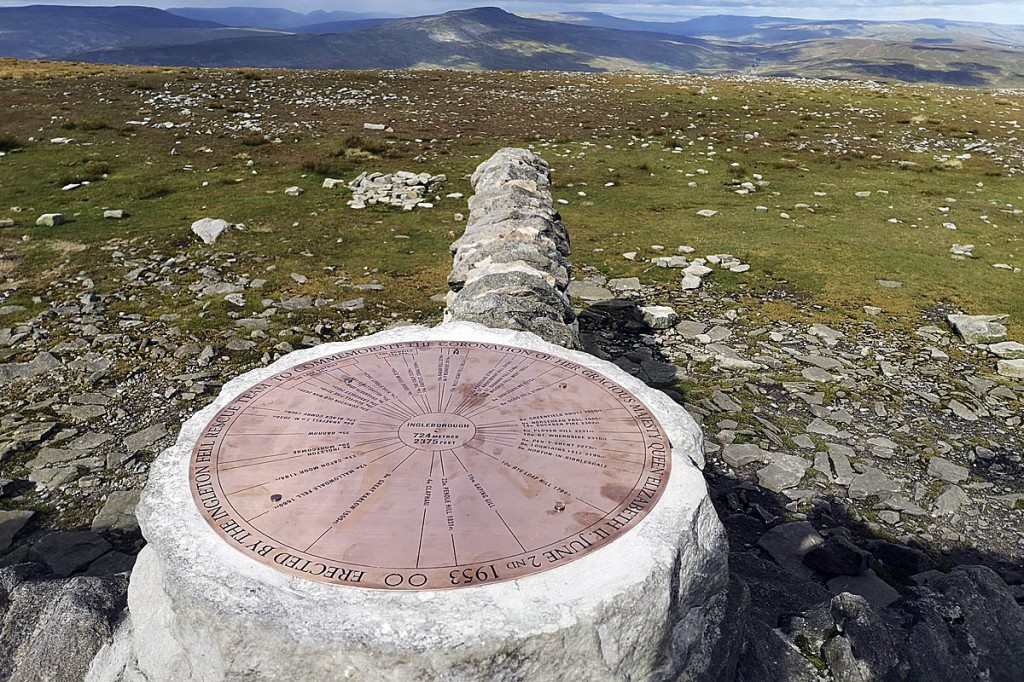A structure that has provided welcoming shelter for hillgoers on one of Yorkshire’s Three Peaks for more than 60 years has been restored and rebuilt.
A badly worn toposcope on the Ingleborough summit cross shelter has been replaced with a replica of the original.
The shelter and the circular bronze plate at its centre were completed just in time for the Queen’s coronation on 3 June 1953.
The shelter’s four walls point to the cardinal compass points, meaning whichever the wind direction, members of the public should be able to find some protection from the elements while they eat their lunch or recover from the ascent of the 723m (2,372ft) mountain. The bronze orientation table points to various landmarks visible on a clear day from the fell’s summit.
The replica toposcope retains the original inscription: ‘Erected by the Ingleton Fell Rescue Team to commemorate the coronation of her gracious majesty Queen Elizabeth II. June 2nd 1953’. It also indicates the original plaque’s height for Ingleborough, a metre higher than the most recent survey altitude.
During the summer the four walls of the shelter were dismantled and rebuilt. Drystone Walling Association master craftsman Laurie Lambeth led the work, which included replacing the large flag stone seats. The new, replica bronze toposcope was installed last month to finish the job.
The shelter was built when in February 1952 when a garage owner from Ingleton came up with a grand idea to commemorate the imminent coronation of Queen Elizabeth II.
Reg Hainsworth wanted to light a beacon on the summit of Ingleborough and erect a permanent stone shelter. The Ingleton Fell Rescue Team which he led took on the project.
Materials for the renovation, such as sand, flags and cement were lifted to the site by helicopter, but the original builders had a much tougher time of it, as Bill Hinde, 84, a volunteer on the original project, recalled. He said: “Reg, having the local dealership for Ferguson tractors, had access to the appropriate vehicles and he knew all the local farmers, which was invaluable in getting building materials up Cod Bank on to Little Ingleborough.
“Most was moved by hand up the final steep slope but on occasions a Fergie with a link box made a suicidal trip up the rake, the final part of the current footpath from Gaping Gill to the summit.
“There were many logistical problems, various vehicles getting stuck, some for many days including Reg’s breakdown truck. The most assured way of moving small quantities was in your rucksack but building tools and materials become heavier the further you carry them.
“Building stone had to be found and carried from the upper millstone slopes as nothing could be used from the summit plateau and water came from the Swine Tail spring and was stored in milk kits.”
Yorkshire Dales National Park Authority member champion for cultural heritage Julie Martin said: “The summit of Ingleborough is a scheduled ancient monument, in part because it had been long thought to be the site of an Iron Age hillfort, although recent research disputes that.”
Mr Hinde checked the minute books of the Ingleton Fell Rescue Team to confirm that the brass toposcope was bought for £45/10/0 (£45.50) from Robert Pringle & Sons, a London silversmith. The toposcope indicated the direction and the distance to the fells that could be seen from the Ingleborough summit, marking, for instance, the 39 miles to Scafell Pike in the Lake District, 22 miles to Pendle Hill in Lancashire and even 84 miles to Snaefell on the Isle of Man.
From the beginning the summit shelter attracted attention from around the world. Reporters ventured to the top of the mountain for interviews with Ingleton Fell Rescue; the BBC recorded an item for the North Countryman programme.
Mr Hinde said that although the weather turned ‘miserable’ for the unveiling of the shelter on the evening before the coronation, a great deal of work went into the beacon.
He said: “The beacon or bonfire was and is a traditional Ingleton celebration of national events.
“The logistics of getting the combustible materials on to the summit of Ingleborough was a serious undertaking but Reg Hainsworth and other locals had past experience. Tractors and trailers had to be organised with manpower to load and unload and local knowledge of the terrain was vital.
“The materials were manhandled by a long continuous line of helpers up the final steep slope on to the summit plateau where the expert bonfire builders did their stuff. Basically, this was a mountain of old tyres stacked around a core of scrap timber with the odd drum or two of old engine oil.
“The beacon was ignited by a flaming torch carried in relay by pupils from Ingleton School.”
The restoration has been carried out by the Yorkshire Dales National Park Authority as part of Yorkshire Dales Millennium Trust’s Stories in Stone programme funded by the National Lottery Heritage Fund.
Ms Martin said: “There is a fantastic story behind Ingleborough’s summit shelter. As well as being a practical structure used for respite by many people walking Yorkshire’s Three Peaks, it stands as a magnificent tribute by local people to the Queen.
“It’s good that once again people can study the toposcope and learn the distances and directions to all the surrounding peaks. I would like to thank our rangers and all the partners involved for carrying out the repair work in such a sensitive way.”
Don Gamble, Stories in Stone scheme manager, said: “The scheme has delivered around 170 projects but most of them have been in the valleys and settlements around the summit, so this project is literally a high point of the scheme.
“I’m sure the shelter will be appreciated by walkers for decades to come.”
A 15-minute film on the project can be seen on YouTube.
The YouTube film detailing the history of the structure and its restoration


Carole (Bennett) Clark
07 December 2020My comment is to say how very grateful I was for the ‘cross wall’ shelter on top of Ingleborough on November 4/5, 1963. On the 4th, together with 3 friends, we took a bus to Ingleton with the intention of climbing the big hill that day. We were young and, in hindsight, very naive as we started our climb mid-afternoon. Needless to say, it wasn’t long before dusk descended on us and, by the time we’d clambered to the top, it was dark. I can’t recall the details of how we found the shelter; I’m so very glad we did because we could feel the damp and cold right in our bones.
Before we set off on this journey, we must have decided we would make ourselves something to eat at some time. One member of our group had a small primus stove; another had a can of soup, which we heated up and shared. We were enjoying ourselves until we tried to find a way down the hill. It all looked too dangerous to attempt this in the dark, even though we had a flashlight. We had no idea which side we should go down to get back to Ingleton.
Once back at the shelter, we huddled together then ran around the wall several times trying to get warm. The thought of spending the whole night on top of Ingleborough was a daunting prospect. The running and resting went on for what seemed a very long time.
As it got closer to midnight, we thought we heard voices. We listened more intently and, sure enough, we were right. We yelled out to get their attention. It was a group of young men who had climbed up to let off fireworks to celebrate Guy Fawkes Day. I’m sure they were as surprised to see as as we were to see them. We were so grateful for the hot tea and cakes they shared with us.
In time, we were led down the hill into Ingleton where, at 2:00 am, we went into an empty transport cafe/bed and breakfast. The manager was hesitant about allowing two young men and two young women - girlfriends and boyfriends - to sleep there. We each had a bed in the one big room and fell asleep, completely exhausted.
This was a long, long time ago and yet I still remember most of that adventure.